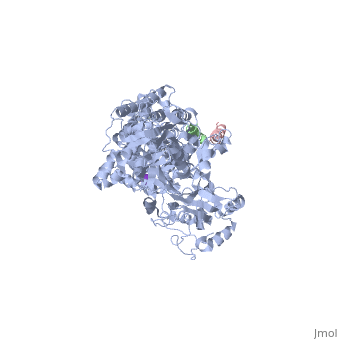4y3u: Difference between revisions
m Protected "4y3u" [edit=sysop:move=sysop] |
No edit summary |
||
| Line 1: | Line 1: | ||
''' | ==The structure of phospholamban bound to the calcium pump SERCA1a== | ||
<StructureSection load='4y3u' size='340' side='right' caption='[[4y3u]], [[Resolution|resolution]] 3.51Å' scene=''> | |||
== Structural highlights == | |||
<table><tr><td colspan='2'>[[4y3u]] is a 3 chain structure with sequence from [http://en.wikipedia.org/wiki/ ] and [http://en.wikipedia.org/wiki/Oryctolagus_cuniculus Oryctolagus cuniculus]. Full crystallographic information is available from [http://oca.weizmann.ac.il/oca-bin/ocashort?id=4Y3U OCA]. For a <b>guided tour on the structure components</b> use [http://oca.weizmann.ac.il/oca-docs/fgij/fg.htm?mol=4Y3U FirstGlance]. <br> | |||
</td></tr><tr id='ligand'><td class="sblockLbl"><b>[[Ligand|Ligands:]]</b></td><td class="sblockDat"><scene name='pdbligand=K:POTASSIUM+ION'>K</scene></td></tr> | |||
<tr id='NonStdRes'><td class="sblockLbl"><b>[[Non-Standard_Residue|NonStd Res:]]</b></td><td class="sblockDat"><scene name='pdbligand=UNK:UNKNOWN'>UNK</scene></td></tr> | |||
<tr id='related'><td class="sblockLbl"><b>[[Related_structure|Related:]]</b></td><td class="sblockDat">[[4kyt|4kyt]]</td></tr> | |||
<tr id='activity'><td class="sblockLbl"><b>Activity:</b></td><td class="sblockDat"><span class='plainlinks'>[http://en.wikipedia.org/wiki/Calcium-transporting_ATPase Calcium-transporting ATPase], with EC number [http://www.brenda-enzymes.info/php/result_flat.php4?ecno=3.6.3.8 3.6.3.8] </span></td></tr> | |||
<tr id='resources'><td class="sblockLbl"><b>Resources:</b></td><td class="sblockDat"><span class='plainlinks'>[http://oca.weizmann.ac.il/oca-docs/fgij/fg.htm?mol=4y3u FirstGlance], [http://oca.weizmann.ac.il/oca-bin/ocaids?id=4y3u OCA], [http://www.rcsb.org/pdb/explore.do?structureId=4y3u RCSB], [http://www.ebi.ac.uk/pdbsum/4y3u PDBsum]</span></td></tr> | |||
</table> | |||
== Function == | |||
[[http://www.uniprot.org/uniprot/AT2A1_RABIT AT2A1_RABIT]] This magnesium-dependent enzyme catalyzes the hydrolysis of ATP coupled with the translocation of calcium from the cytosol to the sarcoplasmic reticulum lumen. Contributes to calcium sequestration involved in muscular excitation/contraction (By similarity). [[http://www.uniprot.org/uniprot/PPLA_CANFA PPLA_CANFA]] Phospholamban has been postulated to regulate the activity of the calcium pump of cardiac sarcoplasmic reticulum. | |||
<div style="background-color:#fffaf0;"> | |||
== Publication Abstract from PubMed == | |||
P-type ATPases are a large family of enzymes that actively transport ions across biological membranes by interconverting between high (E1) and low (E2) ion-affinity states; these transmembrane transporters carry out critical processes in nearly all forms of life. In striated muscle, the archetype P-type ATPase, SERCA (sarco(endo)plasmic reticulum Ca2+-ATPase), pumps contractile-dependent Ca2+ ions into the lumen of sarcoplasmic reticulum, which initiates myocyte relaxation and refills the sarcoplasmic reticulum in preparation for the next contraction. In cardiac muscle, SERCA is regulated by phospholamban (PLB), a small inhibitory phosphoprotein that decreases the Ca2+ affinity of SERCA and attenuates contractile strength. cAMP-dependent phosphorylation of PLB reverses Ca2+-ATPase inhibition with powerful contractile effects. Here we present the long sought crystal structure of the PLB/SERCA complex at 2.8 A resolution. The structure was solved in the absence of Ca2+ in a novel detergent system employing alkyl mannosides. The structure shows PLB bound to a previously undescribed conformation of SERCA in which the Ca2+ binding sites are collapsed and devoid of divalent cations (E2-PLB). This new structure represents one of the key unsolved conformational states of SERCA and provides a structural explanation for how dephosphorylated PLB decreases Ca2+ affinity and depresses cardiac contractility. | |||
The | The Structural Basis for Phospholamban Inhibition of the Calcium Pump in Sarcoplasmic Reticulum.,Akin BL, Hurley TD, Chen Z, Jones LR J Biol Chem. 2013 Aug 31. PMID:23996003<ref>PMID:23996003</ref> | ||
From MEDLINE®/PubMed®, a database of the U.S. National Library of Medicine.<br> | |||
</div> | |||
== References == | |||
[[Category: | <references/> | ||
[[Category: Hurley, T | __TOC__ | ||
</StructureSection> | |||
[[Category: Calcium-transporting ATPase]] | |||
[[Category: Oryctolagus cuniculus]] | |||
[[Category: Hurley, T D]] | |||
[[Category: Ca-atpase]] | |||
[[Category: Membrane protein]] | |||
[[Category: Serca1a]] | |||
Revision as of 16:50, 25 February 2015
The structure of phospholamban bound to the calcium pump SERCA1aThe structure of phospholamban bound to the calcium pump SERCA1a
Structural highlights
Function[AT2A1_RABIT] This magnesium-dependent enzyme catalyzes the hydrolysis of ATP coupled with the translocation of calcium from the cytosol to the sarcoplasmic reticulum lumen. Contributes to calcium sequestration involved in muscular excitation/contraction (By similarity). [PPLA_CANFA] Phospholamban has been postulated to regulate the activity of the calcium pump of cardiac sarcoplasmic reticulum. Publication Abstract from PubMedP-type ATPases are a large family of enzymes that actively transport ions across biological membranes by interconverting between high (E1) and low (E2) ion-affinity states; these transmembrane transporters carry out critical processes in nearly all forms of life. In striated muscle, the archetype P-type ATPase, SERCA (sarco(endo)plasmic reticulum Ca2+-ATPase), pumps contractile-dependent Ca2+ ions into the lumen of sarcoplasmic reticulum, which initiates myocyte relaxation and refills the sarcoplasmic reticulum in preparation for the next contraction. In cardiac muscle, SERCA is regulated by phospholamban (PLB), a small inhibitory phosphoprotein that decreases the Ca2+ affinity of SERCA and attenuates contractile strength. cAMP-dependent phosphorylation of PLB reverses Ca2+-ATPase inhibition with powerful contractile effects. Here we present the long sought crystal structure of the PLB/SERCA complex at 2.8 A resolution. The structure was solved in the absence of Ca2+ in a novel detergent system employing alkyl mannosides. The structure shows PLB bound to a previously undescribed conformation of SERCA in which the Ca2+ binding sites are collapsed and devoid of divalent cations (E2-PLB). This new structure represents one of the key unsolved conformational states of SERCA and provides a structural explanation for how dephosphorylated PLB decreases Ca2+ affinity and depresses cardiac contractility. The Structural Basis for Phospholamban Inhibition of the Calcium Pump in Sarcoplasmic Reticulum.,Akin BL, Hurley TD, Chen Z, Jones LR J Biol Chem. 2013 Aug 31. PMID:23996003[1] From MEDLINE®/PubMed®, a database of the U.S. National Library of Medicine. References
|
| ||||||||||||||||||||||
